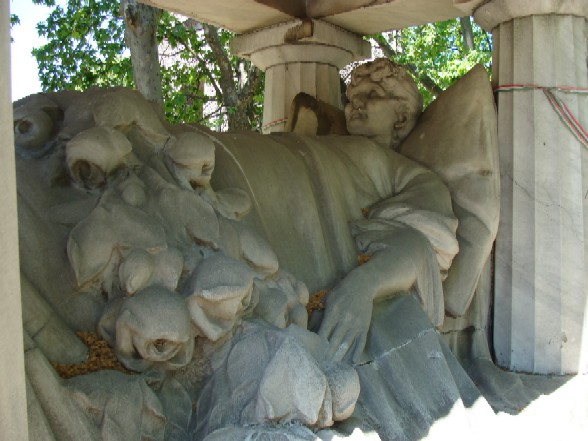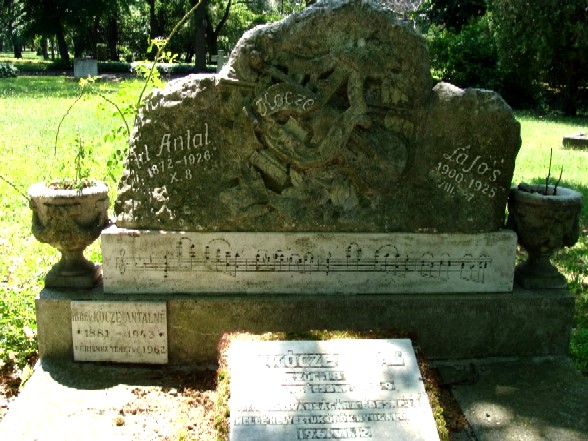Kerepesi Cemetery
Have you ever visited a place in another country without preparing yourself in advance with information about it? Did you find that the place was not a regular tourist destination and therefore you didn’t find onsight tour guides or at least a pamphlet printed in four languages?
Were you astounded and yet not comprehending of what you were seeing?
Did you leave with the sense that you have just visited a truly extraordinary place that you must now learn all you can about?
In Budapest that place for us was Kerepesi Cemetery.
We wondered for three hours through a magical sculpture park masquerading as a cemetery. Huge mausoleums, two long arcades, and hundreds of free standing graves. We rarely saw any grave without at least a life size statue incorporated into its tombstone.
I’m going to show you some pictures. And tell you what we knew at the time, or at least surmised, about this cemetery and these pictures. Then I’m going to add the facts we learned from our research after returning home.
Lujza Blaha: 1850 – 1926

Our reaction: “Wow, that’s one WELL FED rich lady. I wonder who she was?”
The facts: She was born as Lujza Rendl. At an early age she was extremely popular as a child actor. She married conductor Janos Blaha in 1866 and changed her name. She went on to be the most popular female actor and singer of her time, earning many major awards and having a square named after her in the city. Her title was: “The Nation’s Nightingale”. She died of pneumonia.
Bela Pallik: 1854 – 1908
Our reaction: “With the big cross, the staff, and the sheep, we’re guessing – Priest? You know, ‘good shepherd’ and all that.”
The facts: Bela Pallik is considered to be one of Europe’s most important animal painters from the Hungarian school. He is most well known for his depictions of farm animals, especially sheep. duh Here is his most famous painting.

Adolph Czako: 1860 – 1942
Our reaction: “Hey, look. It’s Harry Potter as an old man! See, he even has the scar on his forehead.”
The facts: Dr. Aldolph Czako was the Dean of Engineering for Budapest University of Technology and Economics (the MIT of Hungary). In 1920, he led a fight to prevent the radical right at the university from implementing racial quotas designed to exclude Jews from entry.
Mihaly Vorosmarty: 1800 – 1855

Our reaction: “This is probably the guy our street is named after. Wonder what he is famous for.”
The facts: Yes, he is indeed the guy our street was named for. He was a poet, and acclaimed as a national treasure. His funeral was on November 21st which was declared a national day of mourning, and ensured that a street would be named after him, and one after his funeral date. There is a square named for him as well. Here is his monument in that square.

Antal Kocze: 1872 – 1926
Our reaction: “Wish we could read music. Maybe we’d recognize the song and figure out who he was.”
The facts: Not likely since we aren’t familiar with Gypsy music. A master violinist and composer, he was called “King of the Hungarian Gypsy Virtuosos”. His music was and is performed by many well known Gypsy bands.if you google his name you will get 11 pages of listings.
Here is a link to a listing where you can here a few bars from some of the songs he wrote. Not performed by him, of course.
http://www.classicsonline.com/catalogue/product.aspx?pid=257249
We have dozens of photographs from our day at Kerepesi. Most of them, I will never be able to identify without going back for another visit and making detailed notes for research. Hmmmm…
I’ll leave you with a few of my favorites.




A Brief History of Kerepesi Cemetery, its Hugarian name: Kerepesi uti temeto.
It was founded in 1847, however the first burial was not until 1849. In 1885 the municipal authorities declared that Kerepesi was Budapest’s “Ground of Honour”. This ensured that most of the countries notable statesmen, writers, sculptors, architects, artists, composers, scientists, actors, and actresses would be interred there. The first notable burial was Mihaly Vorosmarty in 1855.
The cemetery was declared closed for burials in 1952. Partly because of damages during WWII and partly for political reasons because the Communist wanted to divert attention away from the graves of those who were perceived to have “exploited the working class”.
In 1958, during the Socialist Period, a Mausoleum for the Labour movement was created and burials began again. In 1989, after the fall of Communism, the burials ceased for a final time, and almost all references to communism were removed from tombs. The scars where red stars were chiseled off are still visable on many monuments.
However, the cemetery is still perceived to be “The Communist Cemetery”, causing many to avoid it. A notable example: One of the sons of famous composer, Bela Bartok, refused to allow his father’s ashes to be interred there.
At 58 hctrs., it is indeed the largest sculpture park in Europe.
The cemetery is now a quiet park with fewer and fewer surviving families to visit its eternal residents.
research credits:
http://disappearingbudapest.blogspot.com
http://en.wikipedia.org/wiki/Kerepesi_Cemetery
http://www.findagrave.com/php/famous.php?FScemeteryid=639592&page=cem






What an awesome post! I love all the photos but esp. the painter of sheep – something very sweet about him. That is truly an amazing place – thanks so much for sharing it.
Deborah responds: Thanks, Annie. I loved him too! There were so many more great sculptures. It was hard to pick just a few to post.
Unlike the U.S., Europe seems to have a story around every corner. Maybe that’s “hiSTORY” around every corner.
Driving around Italy, I’ve often wondered about the story “in” a building I’ve seen, or the gazebo in the town square, or an unexpected statue, but seldom take the time to research it further.
Your fascinating post suggests there’s a world of riches to be gained in that exploration. Scintillating and engaging, Deborah. Thanks!
Deborah responds: Interesting observations, Brad. Perhaps you are on to something. Maybe the SlowTrav bloggers should put together a proposal to the Travel Channel for a show based on you concept. We could call it: “The Story The Guide Books Didn’t Tell You”
This was an incredibly interesting post – wow – between the photos, thoughts and facts, I loved it!
Deborah responds: So, Kim…when will you be booking your trip to Budapest? 😀
Fascinating! I am so appreciative of your posts from this latest trip. It has definitely put eastern europe higher on my list.
Deborah responds: Thanks, Amy. I’ve still got a LOT to say about Budapest. It is a city we will visit again. Did you know that there is an equally impressive Jewish cemetery next door to Kerepesi? We would have loved to have seen it, however it wasn’t open to the public. We had to be content with looking through the fence.
Hmmm….2011 is looking like a distinct possibility 🙂
Fascinating post! I’ve never thought of visiting a cemetery while on vacation. On my next trip I won’t pass on the opportunity to visit one. Fabulous photos! My favorite two are the middle ones in the group of six.
Deborah responds: Maria, Cemeteries are high on our list of places to visit in new cities. I’ve always had the feeling that you can learn so much about a culture by the way they bury their dead.
There was a large bushy area that blocked the grave with the woman sitting from view until we were almost upon it. I actually startled when it came into view because it looked so life like.
wow! the cemeteries i’ve been to are plain, nothing like this. i’d love to visit a cemetery a grand as this.
Deborah responds: You should put it on you places-to-visit list for sure.